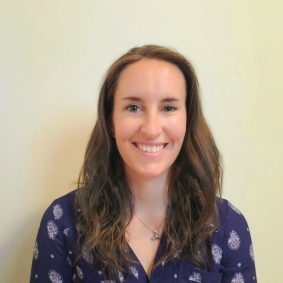Knauss legislative fellowships in Congress help build careers — and they're fun and educational. See our video and fact sheet for details.
Amber Fandel

Fellowship Institution:
NOAA Office of Legislative and Intergovernmental AffairsStart Year:
2022Amber Fandel was a master's student in the Marine and Estuarine Environmental Science graduate program at the University of Maryland Center for Environmental Science. She worked with Dr. Helen Bailey at the Chesapeake Biological Laboratory to determine the presence and behaviors of marine mammals in the western Atlantic Ocean and Chesapeake Bay. She figures all this out using only the sounds these animals make.
Amber is originally from Massachusetts but has lived and worked all over the world. She received her undergraduate degree from Occidental College in Los Angeles, studied abroad in Costa Rica, and worked in Arizona and Nevada for AmeriCorps. She also researched dolphin behavior in southern California and worked in the U.S. House of Representatives and for a congressional election campaign. Amber loves to cook and volunteer, play music and travel, and to hike and paddleboard with her dog.
Program Announcements
-
-
Maryland Sea Grant has program development funds for start-up efforts, graduate student research, or strategic support for emerging areas of research. Apply here.
News and Blogs
Video Gallery
Sea Grant Film Explores a Diminishing Smithville
Smithville is a community on Maryland’s Eastern Shore, on the edge of the Blackwater National Wildlife Refuge. A century ago, Smithville had more than 100 residents. Today, it has four, in two homes: an elderly couple, and one elderly woman and her son, who cares for her.
Featured Fellow
Featured Research Project
Developing a habitat model for mysids, an important link in Chesapeake Bay food webs
Mysids are important mesozooplankton prey for many species of fish in Chesapeake Bay and are an important link in transferring energy from lower to upper trophic levels. Mysids also serve as biological vectors for benthic-pelagic coupling due to their diel vertical migration and omnivorous prey-switching behavior, which makes mysids important regulators of food web architecture. Despite their central role in coastal food webs, surprisingly little is known about mysid ecology and dynamics in Chesapeake Bay.
The Blue Crab: Callinectes Sapidus
An essential resource for researchers, students, and managers. Get your copy today!
Chesapeake Quarterly Magazine
Restoration Takes Root: Living Shorelines for Changing Coasts


©2025 Maryland Sea Grant. All rights reserved.
5825 University Research Court, Suite 1350 | College Park, MD 20740
Phone: (301) 405-7500 | Fax: (301) 314-5780 | Contact Us



